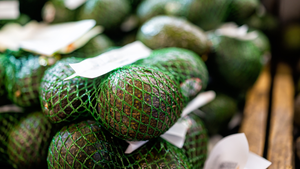Traditional supermarkets lose share as playing field shiftsTraditional supermarkets lose share as playing field shifts
Fresh formats, deep discounters, dollar stores, mass merchants snare more food retail dollars
September 11, 2019
Traditional supermarkets last year lost food retail market share to nontraditional grocery competitors and convenience stores, according to new research from Inmar Analytics.
In 2018, the traditional grocery retail channel — supermarkets, fresh formats, limited-assortment stores, superwarehouses and small grocery stores — saw sales decline 1.1% to $547.63 billion, lowering dollar share 1.7% year over year to 43.8%, Inmar said in its 2019 Future of Food Retailing Report. The channel’s total store count dipped 0.5% to 40,379.
Meanwhile, food and consumables sales for nontraditional grocery retailers — wholesale clubs, supercenters, discounters, dollar stores, drug stores and military commissaries — rose 1.9% to $500.58 billion in 2018, raising dollar share 1.3% to 40%. Store count edged up 0.9% to 64,451.
Sales of food and consumables also advanced at convenience stores, up 2.2% to $201.69 billion (excluding fuel) overall last year for a 1.6% gain in dollar share to 16.1%. The number of C-stores, however, fell 1.1% to 159,700.
Across all food retail formats, sales totaled $1.25 trillion in 2018, inching up 0.5%, Inmar reported. Store count was down 0.5% to 264,530.
“Established CPG brands and grocery retailers need to embrace new strategies for driving growth in a marketplace where sales volume and profit are suffering continuous contraction, with an increased focus on innovation,” Jim Hertel, senior vice president at Winston-Salem, N.C.-based Inmar, said in a statement. “There are no shortages when it comes to innovative products — from plant-based protein to non-milk to clean meat to CBD oil-infused. The ongoing proliferation of ‘alternative’ offerings would appear to promise real opportunity for successfully activating a shopper base that is seriously committed to dietary improvement involving sustainability and responsible sourcing.”
In its report, Inmar noted that the traditional grocery channel has lost more than half of its food retail market share since 1988, dropping from 90% to 44% in 2018. Over the same time span, nontraditional grocery swelled from 2% market share to 40%, while C-stores jumped from 8% to 16%.
E-commerce sales of food and consumables also have surged, reaching $58 billion in 2018, a year-over-year gain of 21.7%. While online grocery sales volume has risen at traditional retailers, Amazon continues to dominate the space, with its food and consumables sales increasing 23.5% to $21.1 billion last year.
Conventional supermarkets generate the lion’s share of business in the traditional grocery channel, but sales fell 1.7% to $438.01 billion in 2018. Consequently, dollar share declined 2.5% to 35%. The number of traditional supermarkets also was down 1.3% to 24,916, Inmar’s study said. Traditional grocery segments seeing sales growth included limited-assortment stores ( 4.8%), fresh formats ( 3.6%) and small grocery stores ( 3%).

Dollar stores have upped their food retail market share with the addition of more grocery space, including fresh items.
Of note in the nontraditional grocery space, drug stores saw sizable decreases in food and consumables volume, with sales down 6% and share falling 6.1% for 2018. With dollar share of 19.5% — second only to conventional supermarkets among all food retailers — supercenters led the nontraditional grocer field with sales of $243.38 billion, up 3%, followed by wholesale clubs at $115.94 billion, up 3.3%. Dollar stores posted the channel’s largest gain, with food and consumables sales rising 5.7%, but this segment’s food retail dollar share was just 3% last year despite having the most stores (33,382) in the nontraditional grocery arena.
Looking ahead, Inmar projects traditional grocery dollar share to slip 1% to 42.8% by 2023, with conventional supermarkets experiencing a 2.1% share decrease. Fresh formats and limited-assortment stores are expected to see share growth of 0.4% and 0.8% in that time frame, respectively.
Nontraditional grocery’s food retail dollar share is forecast to rise 1.2% to 41.2% in 2023, led by share gains at supercenters ( 1.4%) and dollar stores ( 1.2%). Food and consumables dollar share at convenience stores, meanwhile, is slated to dip 0.6% to 15.5%.
“Traditional grocery stores can no longer expect to be successful simply by serving as CPG-supplied ingredient warehouses, enabling at-home meal preparation by stocking ubiquitous recipe requirements,” Hertel said in the report. “Seismic shifts in share within the $1.3 trillion food market are making that role increasingly untenable and unprofitable. The remaining pathway to growth is innovation.”
For example, he explained, retailers may need to invest in more shelf space, new store layouts and expanded departments to accommodate assortments of new products and brands sought by consumers, as well as bolster marketing and step up their use of predictive analytics to leverage their stores of customer data.
“Retailers willing to make sufficient investment to fully leverage the innovation delivered by brands,” Hertel said, “will establish themselves as a ‘go-to’ for shoppers looking for new products and build loyalty among these customers as they recognize and reward the availability of offerings that support their lifestyles.”
Read more about:
Dollar GeneralAbout the Author
You May Also Like






